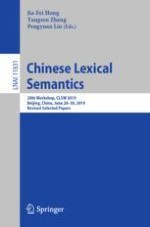2020 | OriginalPaper | Buchkapitel
The Centennial Controversy: How to Classify the Chinese Adverb Dōu?
verfasst von : Hua Zhong
Erschienen in: Chinese Lexical Semantics
Aktivieren Sie unsere intelligente Suche, um passende Fachinhalte oder Patente zu finden.
Wählen Sie Textabschnitte aus um mit Künstlicher Intelligenz passenden Patente zu finden. powered by
Markieren Sie Textabschnitte, um KI-gestützt weitere passende Inhalte zu finden. powered by

 ) and Mandarin
) and Mandarin  b[
b[